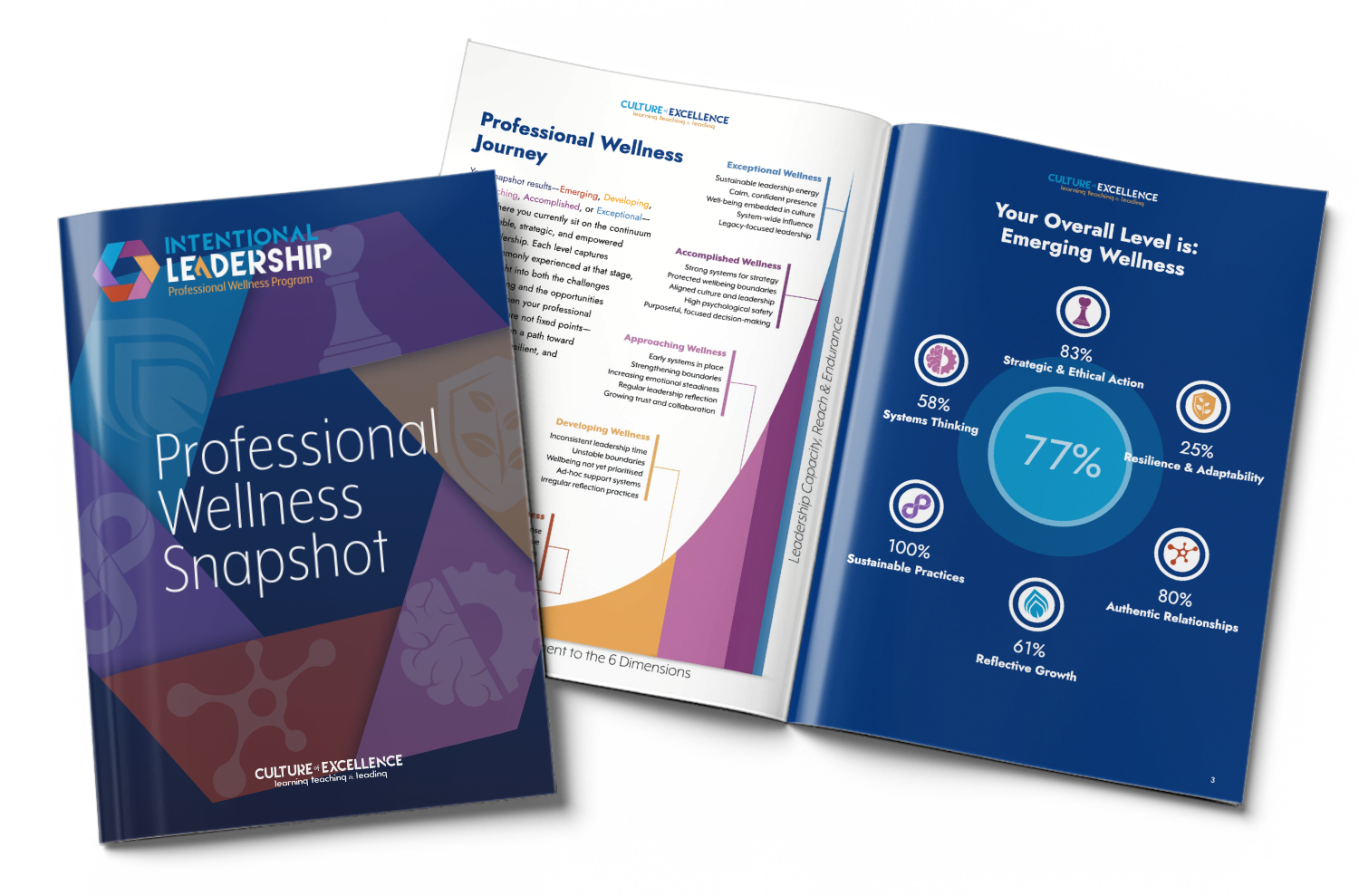
The Leadership Pipeline Is Breaking
Why great leaders are leaving—and fewer are stepping up
This video explores the deeper crisis behind recruitment and retention: the growing perception that school leadership is impossible to sustain. As triage becomes the default, and system pressure continues to rise, even strong leaders are walking away—not because they can’t lead, but because the role no longer allows them to.
If leadership is starting to feel unsustainable—what would need to shift to make you want to stay?
Want to Lead With Steadiness—Not Strain?
Join our FREE Professional Wellness Workshop—a live session where we explore all six dimensions and help you refocus on what really sustains school leadership.

The Leadership Pipeline Is Breaking
Why great leaders are leaving—and fewer are stepping up
“I’m not done leading—I’m just done leading like this.”
That’s the quiet truth I hear over and over. Every week, I speak with leaders who still care deeply about the work—but who are actively planning their exit. Not because they’ve lost the fire, but because the system keeps dousing it.
We’re not losing leaders because they’re not resilient. We’re losing them because the structure is broken.
It’s not a motivation crisis—it’s a system failure
According to the 2024 Australian Principal Occupational Health, Safety and Wellbeing Survey, 53.2% of principals are seriously considering leaving the profession. That number jumps to 82.3% among those with low job satisfaction (ACU, 2025). These are not isolated spikes—they represent a decade-long trend.
The system doesn’t ask what’s sustainable. It asks,"Who can carry more?"
In the U.S., the NASSP’s (2022) Leadership Crisis in Schools report found that 62% of principals considered leaving their positions due to unsustainable demands. And in England, nearly 40% of secondary heads planned to leave the profession within five years, citing workload, wellbeing, and lack of support as core drivers (NAHT, 2021).
This is not a national anomaly. It’s a global signal that the role itself—its conditions, scope, and support—is misaligned with its expectations.
Truth 1: The system is set up to burn out the people it needs most
The irony? The more capable the leader, the more invisible their needs become.
- They handle the emergencies
- They absorb the pressure
- They stay later, give more, and ask for less
And over time, their effectiveness becomes their exposure.
As a principal in New South Wales told me: “I’m managing five jobs. But if I do it well, no one notices. If I drop one, it’s a leadership failure.”
Obviously, this isn’t sustainable. The OECD’s TALIS 2018 study found that school leaders in high-performing systems were twice as likely to report time for collaboration and strategy than those in struggling systems (OECD, 2020). But in Australia, New Zealand, and the UK, leaders increasingly report “chronic reactivity” as their daily norm (Riley et al., 2021; NAHT, 2021).
The system doesn’t ask what’s sustainable. It asks, "Who can carry more?", and that question is breaking people.
Truth 2: Leadership no longer feels aspirational—it feels avoidable
We often talk about the pipeline, but pipelines don’t just go dry—they get blocked by bad examples. I’ve worked with deputy principals who’ve turned down promotions, and teachers who’ve completed leadership training and then just walked away. Not because they’re incapable, but because they’re observant.
“I’ve seen what the job does to people,” one aspiring leader told me. “No, thank you.”
This is supported by research from the Grattan Institute (Goss & Sonnemann, 2020), which found that one of the biggest barriers to school leadership succession is the perceived cost to well-being and identity. If all they see is depletion, they won’t step up, and they shouldn’t until leadership becomes livable, it will not be aspirational.
Truth 3: Retention isn’t about resilience—it’s about redesign
Resilience is important, but right now, it’s being misused. We hand leaders another resource pack, another breathing exercise, another reminder to care for themselves—but no structural relief. What leaders need isn’t just supporting resources; they need a restructured role.
This aligns with Leithwood et al. (2020), who argue that leadership sustainability depends on “institutional practices that support decision-making agency, time protection, and professional growth.” This echoes Heifetz and Linsky’s (2002) work: adaptive challenges can’t be solved with technical fixes.
So let’s be clear: You can’t "mindfulness" your way out of a broken staffing model. You can’t debrief your way out of job creep. And you can’t resilience-train your way out of structural imbalance.
Retention will not improve because people tough it out. It will improve when we design leadership roles that are actually leadable.
A better system is possible—but only if we name what’s broken
This isn’t about blame—it’s about design and clarity. If over half of our leaders are planning to leave, the problem isn’t passion or mindset; it’s the conditions. And if you’ve ever thought, “I love this work but not this version of it”, that’s not a weakness—that’s a signal.
You’re not broken. You’re noticing what doesn’t work. And you’re not alone.
What would need to change to make school leadership sustainable again?
References
Australian Catholic University. (2025, March 31). Principals navigate growing challenges as anxiety, depression increase. https://www.acu.edu.au/about-acu/news/2025/march/principals-navigate-growing-challenges-as-anxiety-depression-increase
Grattan Institute. (2020). Making Time for Great Teaching. https://grattan.edu.au/report/making-time-for-great-teaching/
Heifetz, R. A., & Linsky, M. (2002). Leadership on the Line: Staying Alive Through the Dangers of Leading. Harvard Business Review Press.
Leithwood, K., Harris, A., & Hopkins, D. (2020). Seven strong claims about successful school leadership revisited. School Leadership & Management, 40(1), 5–22.
National Association of Secondary School Principals (NASSP). (2022). The leadership crisis in schools: Principals under pressure. https://www.nassp.org
OECD. (2020). TALIS 2018 Results (Volume II): Teachers and School Leaders as Valued Professionals. https://doi.org/10.1787/19cf08df-en

Not Sure What's Holding You Back?
Take our quick 2-minute Professional Wellness Snapshot to pinpoint where your biggest barrier lies—and which leadership dimension to strengthen next.